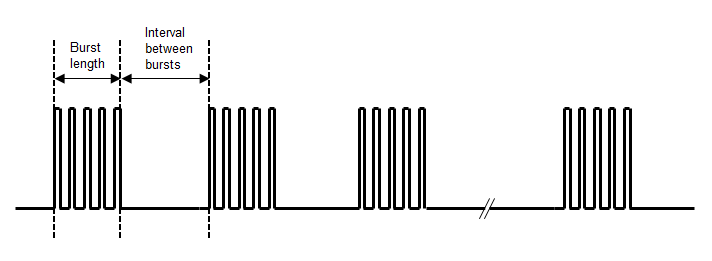
ETSI standard, ETSI 302 502 V1.2.1, is for radio equipments/systems intended to operate in the 5.8 GHz band (5725 MHz to 5875 MHz). It has DFS requirements to make sure the devices have functions to detect transmissions from other systems to avoid co-channel operation with these systems, notably radar systems. DFS is not required in frequency range 5850 MHz to 5875 MHz.
| Radar Type | Pulse Width (μs)1 | Pulse Repetition Frequency PRF(pps) | Number of Pulses per Burst |
|---|---|---|---|
| 1-Fixed | 1 | 750 | 15 |
| 2-Variable | 1, 2, 5 | 200, 300, 500, 800, 1000 | 10 |
| 3-Variable | 10, 15 | 200, 300, 500, 800, 1000 | 15 |
| 4-Variable | 1, 2, 5, 10, 15 | 1200, 1500, 1600 | 15 |
| 5-Variable | 1, 2, 5, 10, 15 | 2300, 3000, 3500, 4000 | 25 |
| 6-Variable modulated2 | 20, 30 | 2000, 3000, 4000 | 20 |
Note:
The pulse width used in these tests is assumed to be representative of real radar systems with different pulse widths and different modulations. The pulse width is assumed to have an accuracy of ±5%.
The modulation to be used for the radar test type 6 is a chirp modulation with ±2.5 MHz frequency deviation.
| Radar Type | Pulse Width (μs) | Pulse Repetition Frequency PRF(pps) | Pulses per Burst | Burst Length (ms) | Burst per Trial1 | Pulse Modulation |
|---|---|---|---|---|---|---|
| 1 | 1 | 3000 | 9 | 3 | 8 | none |
| 2 | 20 | 4500 | 9 | 2 | 2 | chirp2 |
Note:
For each of the trials, the burst interval will increase from 1.25 ms to 37.5 ms in steps of 1.25 ms for radar signal 1 and from 5 ms to 150 ms in steps of 5 ms for radar signal 2.
The modulation to be used for the radar test type 6 is a chirp modulation with ±2.5 MHz frequency deviation.
You also need to note that the burst interval definition in ETSI 302 502 is actually the same as interval between bursts, which is defined as the time length between the end of the last bust and the beginning of the next burst, as shown in Figure 1.

Figure 1. The Definition of Burst Length and Interval Between Bursts in ETSI 302 502